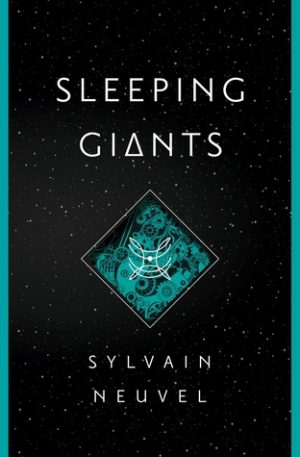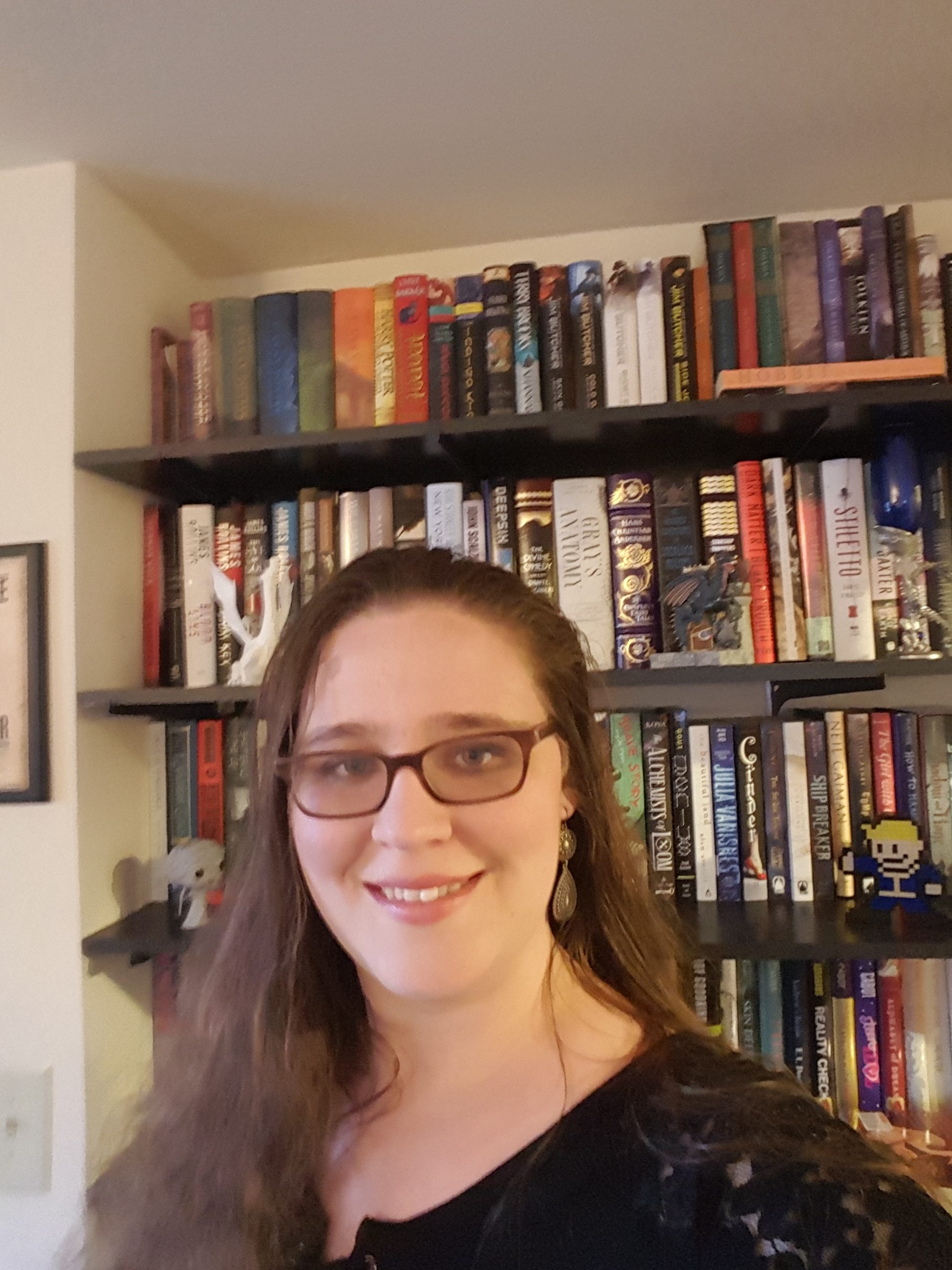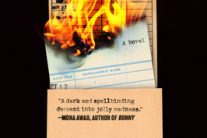 Sleeping Giants
Sleeping GiantsBy: Sylvain Neuvel
Website: http://www.neuvel.net/
Release Date: April 26, 2016
Publisher: Del Rey
Series: Themis Files #1
Award: Goodreads Choice Nominee for Science Fiction (2016)
Rating:
Sleeping Giants by Sylvain Neuvel has been on my radar for some time, and I finally got my hands on a copy. As much as I wanted to read this book, I was a bit hesitant to begin, afraid it would fall short somehow. I’ve gotten myself hyped up for books before only to have my hopes and dreams dashed, and I couldn’t help but be a little nervous. But when the librarian looked at the cover, smiled, and gave it a fond little pat when i set it on the checkout desk I knew I was in safe hands. I really shouldn’t have been so afraid.
But enough about my own irrational fears. What is the book actually about?
The story begins with a young girl named Rose falling into a sinkhole and being caught by a giant metal hand. Years later when Rose is grown and now a scientist, the case of the mysterious hand is reopened. The majority of Sleeping Giants takes place over the course of about two years, following Rose and her team as they attempt to unlock the secrets of this mysterious appendage , figure out if there are more of them, and what the discovery means for humanity as a whole.
The book is told largely through interviews with a mysterious gentleman who is never named and the various members of Rose’s team. Also included are a few military transcripts, mission reports, and experiment logs. It is definitely not ‘traditional’ storytelling, which works particularly well for this tale. The formatting isn’t quite as graphically impressive from a pure graphical standpoint as something like Illuminae, but still falls well within nontraditional storytelling.
The events of the story take place over a span of several years. Honestly, I do sometimes find that books which span such long time frames and have a bigger cast of characters can drag on, and don’t always feel very connected to the characters, main or supporting. I didn’t have either of those problems with Sleeping Giants. We get a surprising amount of personality in the interviews, and a clearer picture of some of the characters than even the most beautiful, long-winded descriptions science fiction and fantasy can provide. Honestly, I grew very attached to the nameless interviewer. He proved to be a much more complex character than I initially expected, and I sincerely hope we see more of him in the next book of the series.
There is a lot going on in this book, more than may first appear. There is just as much political intrigue within the story as there is science fiction. Relations between the characters are volatile, and change as much as one would expect within such a long span of time. Relations between countries are very tenuous, coming to a head in the later portion of the novel.
I was particularly impressed with how the action scenes, the majority of which are in the second half of the book, played out. Most of these were not told in interviews or diary entries, but as phone calls between the interviewer far away and in relative safety and the characters on the ground in the midst of the unfolding chaos. These scenes were very exciting, very ‘in the moment’. Nothing was lost by having the novel told through these phone calls and interview sequences. If anything, the danger felt more immediate, more imposing, and the inability of the interviewer to help, being so far away with no power but his intellect and abilities of delegation, was palpable. And, honestly, are some of the best action and battle type scenes I’ve come across in some time.
The book also asks some big questions. How much are we willing to sacrifice for the pursuit of science? When is the sacrificing of human life acceptable? At what point do we draw the line? What are we willing to forgive people for? Can current actions make up for past atrocities?
I liked the first half of the book. But it was the second half that really had me hooked. The stakes rise quite a bit and do so consistently right to the end of the novel. By the time you hit the 2/3 marker it’s full steam ahead to the end. And that ending! I don’t want to say too much, because I don’t want to get into spoiler-heavy territory. The next book can’t come fast enough. I need to know what happens next.
Now, one thing I cannot completely speak to is the comparison of Sleeping Giants to The Martian and World War Z. I’ve seen the comparison made several times in various places. Both books are on my to-read pile, but I haven’t gotten to either just yet. What I can say is that Sleeping Giants does bear similarities to mecha anime. Think Gurren Lagann. If you like that genre, you’ll probably find a lot to like within this book.
Sleeping Giants is a brilliant first book in a new science fiction series. I will most definitely be picking up the sequel when it releases. If you like science fiction, political thrillers, or giant robot anime you will most definitely like this book.
Sleeping Giants by Sylvain Neuvel has been on my radar for some time, and I finally got my hands on a copy. As much as I wanted to read this book, I was a bit hesitant to begin, afraid it wouldn’t live up to the hype it had gotten and my own expectations. But when the librarian looked at the cover, smiled, and gave it a fond little pat when i set it on the checkout desk I knew I was in for a real treat.
The story begins with a young girl named Rose falling into a sinkhole and being caught by a giant metal hand. Years later when Rose is grown and now a scientist, the case of the mysterious hand is reopened and she is put in charge of the operation. The majority of Sleeping Giants takes place over the course of about two years, following Rose and her team as they attempt to unlock the secrets of this mysterious appendage , figure out if there are more of them, and what the discovery means for humanity as a whole.
The book is told largely through interviews with a mysterious gentleman who is never named and the various members of Rose’s team. Also included are a few military transcripts, mission reports, and experiment logs. It is definitely not ‘traditional’ storytelling, which works particularly well for this tale. The formatting isn’t quite as artistic as something like Illuminae, but falls well within nontraditional storytelling nonetheless.
We get a surprising amount of personality in the interviews, and a clearer picture of some of the characters than even the most beautiful, long-winded descriptions science fiction and fantasy can provide. Honestly, I grew very attached to the nameless interviewer. He proved to be a much more complex character than I initially expected, and I sincerely hope we see more of him in the next book of the series.
There is a lot going on in this book, more than may first appear. There is just as much political intrigue within the story as there is science fiction. Relations between the characters are volatile, and change as much as one would expect within such a long span of time. Relations between countries are very tenuous, coming to a head in the later portion of the novel.
I was particularly impressed with how the action scenes, the majority of which are in the second half of the book, played out. Most of these were not told in interviews or diary entries, but as phone calls between the interviewer, far away and in relative safety, and the characters on the ground in the midst of the unfolding chaos. These scenes were very exciting, very ‘in the moment’. Nothing was lost by having the novel told through these phone calls and interview sequences. If anything, the danger felt more immediate, more imposing, and the inability of the interviewer to help, being so far away with no power but his intellect and abilities of delegation, was palpable. And, honestly, these are some of the best action and battle type scenes I’ve come across in some time.
The book also asks some big questions. How much are we willing to sacrifice for the pursuit of science? When is the sacrificing of human life acceptable? At what point do we draw the line? What are we willing to forgive people for? Can current actions make up for past atrocities?
I liked the first half of the book. But it was the second half that really had me hooked. The stakes rise quite a bit and do so consistently right to the end of the novel. By the time you hit the 2/3 marker it’s full steam ahead to the end. And that ending! I don’t want to say too much, because I don’t want to get into spoiler-heavy territory, but the next book can’t be released fast enough. I need to know what happens next.
Now, one thing I cannot completely speak to is the comparison of Sleeping Giants to The Martian and World War Z, comparisons I’ve seen made several times. Both books are on my to-read pile, but I haven’t gotten to either just yet. What I can say is that Sleeping Giants does bear similarities to mecha anime. Think Gurren Lagann. If you like that genre, you’ll probably find a lot to like within this book.
Sleeping Giants is a brilliant first book in a new science fiction series. I will most definitely be picking up the sequel when it releases. If you like science fiction, political thrillers, or giant robot anime you will most definitely like this book.
You can find our reviews of the rest of the series here:
Waking Gods (Book #2)
Only Human (Book #3)






Post a comment